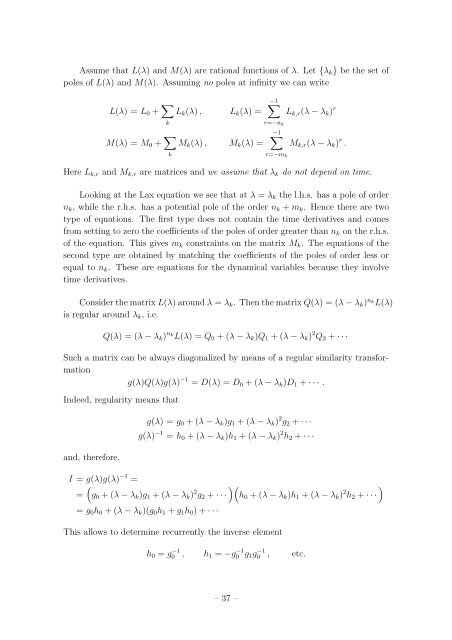Student Seminar: Classical and Quantum Integrable Systems
Student Seminar: Classical and Quantum Integrable Systems
Student Seminar: Classical and Quantum Integrable Systems
Create successful ePaper yourself
Turn your PDF publications into a flip-book with our unique Google optimized e-Paper software.
Assume that L(λ) <strong>and</strong> M(λ) are rational functions of λ. Let {λ k } be the set of<br />
poles of L(λ) <strong>and</strong> M(λ). Assuming no poles at infinity we can write<br />
L(λ) = L 0 + ∑ k<br />
M(λ) = M 0 + ∑ k<br />
L k (λ) , L k (λ) =<br />
M k (λ) , M k (λ) =<br />
∑−1<br />
r=−n k<br />
L k,r (λ − λ k ) r<br />
∑−1<br />
r=−m k<br />
M k,r (λ − λ k ) r .<br />
Here L k,r <strong>and</strong> M k,r are matrices <strong>and</strong> we assume that λ k do not depend on time.<br />
Looking at the Lax equation we see that at λ = λ k the l.h.s. has a pole of order<br />
n k , while the r.h.s. has a potential pole of the order n k + m k . Hence there are two<br />
type of equations. The first type does not contain the time derivatives <strong>and</strong> comes<br />
from setting to zero the coefficients of the poles of order greater than n k on the r.h.s.<br />
of the equation. This gives m k constraints on the matrix M k . The equations of the<br />
second type are obtained by matching the coefficients of the poles of order less or<br />
equal to n k . These are equations for the dynamical variables because they involve<br />
time derivatives.<br />
Consider the matrix L(λ) around λ = λ k . Then the matrix Q(λ) = (λ − λ k ) n k L(λ)<br />
is regular around λ k , i.e.<br />
Q(λ) = (λ − λ k ) n k<br />
L(λ) = Q 0 + (λ − λ k )Q 1 + (λ − λ k ) 2 Q 2 + · · ·<br />
Such a matrix can be always diagonalized by means of a regular similarity transformation<br />
g(λ)Q(λ)g(λ) −1 = D(λ) = D 0 + (λ − λ k )D 1 + · · · .<br />
Indeed, regularity means that<br />
<strong>and</strong>, therefore,<br />
g(λ) = g 0 + (λ − λ k )g 1 + (λ − λ k ) 2 g 2 + · · ·<br />
g(λ) −1 = h 0 + (λ − λ k )h 1 + (λ − λ k ) 2 h 2 + · · ·<br />
I = g(λ)g(λ) −1 =<br />
(<br />
)(<br />
)<br />
= g 0 + (λ − λ k )g 1 + (λ − λ k ) 2 g 2 + · · · h 0 + (λ − λ k )h 1 + (λ − λ k ) 2 h 2 + · · ·<br />
= g 0 h 0 + (λ − λ k )(g 0 h 1 + g 1 h 0 ) + · · ·<br />
This allows to determine recurrently the inverse element<br />
h 0 = g −1<br />
0 , h 1 = −g −1<br />
0 g 1 g −1<br />
0 , etc.<br />
– 37 –

















